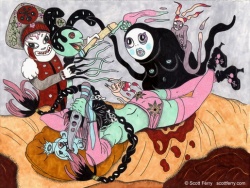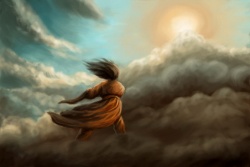Charnel ground
Click here to see other articles relating to word Charnel ground
You are trapped in a horrific video game, crawling with bloodthirsty ghouls. There is no way out.
When you reach the final level, the boss monster will eat you alive: GAME OVER.
It’s your move.
Many people reject Buddhist Tantra in favor of Consensus Buddhism, or modernized Theravada or Zen, because those seem realistic. These modernist Buddhisms sweep under the rug all the monsters, miracles, demons and deities of the Pali and Mahayana scriptures. Buddhism is supposed to be rational, scientific, and pragmatic.
Tantra, by contrast, seems incurably infested with magical superstitions.
I take the opposite view. Tantra is brutally realistic—because reality is brutal. It is Sutra (non-tantric Buddhism) that is a fantasy.
Sutra promises the path beyond all suffering. If you do everything right, you can escape this vale of tears into Neverland Nirvana.
Now there is a magical superstition. That fantasy runs far deeper than mere gods and demons. Spooks, after all, can be exorcized easily by declaring them to be psychological metaphors.
Tantra offers no salvation, no escape, no alternative, and no hope. Now that’s scientific, pragmatic, and sensible.
Antidote to hope
Many Western Buddhists implicitly imagine that Buddhism can somehow be The Answer To Life, The Universe, And Everything. Otherwise, we’d be totally fucked.
This is absurd. Life is diverse, and couldn’t have a single solution. Moreover, life is not a problem, so “solution” or “answer” is beside the point.
Anyway, we’re totally fucked. But existential optimism—“there must be a way out”—makes things worse than necessary. You waste effort chasing imaginary salvation, and keep feeling hurt when it doesn’t work out.
Tantra has an antidote.
It is a “practice of view,” which means developing the habit of interpreting the world in a particular way. Specifically, you view the world as a “charnel ground.”
Charnel grounds, in India, are places where unclaimed human corpses are dumped to rot, or be eaten. The bodies are not buried or burned; they are just left out. That’s a delightful buffet for the local carrion-eaters: jackals and hyenas, tigers and bears, vultures and ravens.
Charnel grounds are dangerous, horrifying, chaotic places. None of the meat-eaters are picky about whether you are dead (except vultures). They are happy to eat living visitors. Unburied corpses also attract demons—in the Indian imagination—and are likely to produce ghosts and vetalas (zombies).
Sane, decent people avoid charnel grounds absolutely. That makes them ideal meeting places for dangerous, marginal people: brigands and spies, for instance, according to lore. Also dakinis (cannibal witches) and yogis (sorcerers): that is, tantric Buddhists.
A tantrika takes the same attitude to reality as to a charnel ground. Reality is a dangerous, horrifying, chaotic place. No one gets out of here alive.
We want to pretend that isn’t true. Most of the time, we convince ourselves that things are going tolerably well, and will get better, and death is remote. We have hope for the future.
Then we are surprised, and unprepared emotionally, any time something bad happens. We think: it wasn’t supposed to be this way! We think: there must be some way out! We think: Help! Buddha save me! These ideas are totally unrealistic, and make it harder to deal with whatever catastrophe is at hand.
General Buddhism recommends that you always remember that death is certain, and the time of death is uncertain.
Tantra goes beyond that: you visualize the full, grisly awfulness of death. This is an instance of the tantric method of intensification: cranking the horror up to eleven.
No escape
Often what people do in horror movies is try desperately to escape—usually in the stupidest way possible.
Religion is mostly also idiotic fantasies of escape.
So let’s cut that right off: there is nowhere you can go where you won’t find monsters feasting on piles of rotting corpses.
The entire universe is a charnel ground. It extends to infinity in every direction: across space, time, all dimensions. There was no glorious creation, no golden age of the past, no possibility of salvation in the future. If there are any alternate worlds, spiritual planes, or magical states of consciousness—they are also entirely charnel ground.
This is a situation of utter claustrophobia.
“But that can’t be true,” maybe you say. “It wouldn’t be fair! Life can’t just be endless suffering!”
Suffering
Tantra is not interested in suffering.
If you complain about suffering, tantra says:
Of course there is suffering! What were you expecting?
You are a disposable walk-on character in a horror movie!
You were hoping for what? Beautiful naked deities, offering you bowls of nectar and ambrosia, maybe?
No existential hope
The point of viewing all reality as a charnel ground is to annihilate existential hope: the hope that you can somehow win the game; the hope that you can somehow escape; the hope that Buddhism will somehow rescue you from old age, sickness, and death.
Now, I hope my girlfriend will give me a Cthulhu plush toy for Christmas. Obviously, my life will be greatly improved if she does. A Cthulhu plush toy is the perfect proof of her affection, a superlative home decoration, and the best possible companion for times when she is away.
But this hope is for a merely practical improvement in my life—a “relative benefit,” in Buddhist jargon. A Cthulhu plush toy is a wonderful thing, but it is not a solution. It is really not very spiritual; it is not an “ultimate” or “absolute” benefit.
Alas: it cannot fix my existential state.
No salvation
It’s easy to misunderstand the method of charnel ground:
Oh, I get it! What a wonderful, paradoxical path to enlightenment! If I just fully embrace hopelessness, then I will be saved!
That is, of course, just more hope.
The only thing hopelessness saves you from is distorted perception. If you fully embrace hopelessness, you are saved from wasting time trying to escape the charnel ground.
But, if everything is utterly hopeless, then “wasting time” is hardly an issue, is it?
Or is it?
No hell on earth
The charnel ground—i.e., everyday reality—is not a hell. Traditional Buddhism does have hells, several of them, but the charnel ground is quite different.
The difference is not in the degree of suffering. Some Buddhist hells might be less bad than some lives in the real world.
The difference is that the inhabitants of hell are so busy feeding their rage that they see no possibility of curiosity, creativity, or celebration.
In hell, nearly everyone has the attitude:
I shouldn’t be here! It wasn’t supposed to be this way! I hate these demons who are torturing me! I hate everyone who had a better rebirth—they think they are so superior! God is a mean motherfucker! It’s not fair!
When you die, the Sorting Hat sends you to your next destination based on your typical emotion in life. For example, if you are angry, you go to hell. That works the same way no matter where you die.
The Hat sends nearly everyone who dies in hell straight back there. Some of the hells are so lethal that the whole process only takes a few seconds per rebirth. So beings die in hell over and over, for countless eons, because they keep getting angry about the whole thing. If you just drop that, then you go somewhere else next time you die.
We can translate this into something practical, using the standard modern Buddhist move of reinterpreting the Six Realms of Rebirth as psychological states.
As long as you are resentful about suffering, as long as you think the world should be different, then you are stuck obsessing over how unfair it is, and scheming about how to escape. And that just makes you angry and miserable all over again.
Charnel ground practice means giving up on that cycle. You simply lose all interest in how life ought to be.
As soon as you forget about “ought to be,” you are left with life just as it is: chaos, horror, death and all.
In that, there is absolutely no hope. But there is opportunity.
Garden of horrors
When you accept that it extends to infinity, you realize that the claustrophobic charnel ground—exactly because there is nowhere else—is a land of total openness and freedom.
You can set off in any direction to explore the scenery. The geography is endlessly varied. There are lakes of fire, rivers of poison, and oceans of blood. There are forests of cannibal trees, and of course the Nameless Lurking Evils at the Mountains of Madness.
So the charnel ground is also a horrifying amusement park. There’s lots to see and do—always something new, in fact.
Instead of trying to escape:
You could have fun compiling an atlas.
You could throw a party. You could invite the zombies. (Just make sure to collect lots of brains first. You wouldn’t want to be a stingy host.)
You could write a geeky identification guide to the many species of demons.
You could grow a garden of poisonous flowers. You could learn alchemy and refine poisonous herbal extracts into magical potions.
You could go talk to the cannibal witches. They’re unusual company. They might eat you, but something else could happen. Romance is possible…
Sooner or later, you’ll die horribly. But you might as well do something interesting in the mean time, not just cower in a corner. Reality is a splatter movie, but it is also an adventure story and a romantic comedy—all at the same time.
Tantra is given to flights of fantasy, because reality is fantastical. Confronted with over-the-top horror in real life, you might as well laugh at the outrageousness of it.
Etcetera
Charnel ground practice has been part of Buddhism from very early on. I’ve written a little about the Sutric (mainstream) approach. Its goal is exactly opposite of tantra’s. The point is to develop “revulsion for samsara.” If you really understood how awful the world is, you’d be sufficiently motivated to escape it. (Whereas, in tantra, you absolutely can’t escape, and even if you could, you shouldn’t want to. It is only in a world of suffering that you can help others.)
In Tibetan Buddhism, the best-known charnel ground practice is chöd. There are several books on chöd, but I can’t really recommend any of them; they are either tediously academic or bizarrely Consensus-y. (Turning a horrifying ritual of demonic human sacrifice into a nice safe brand of psychotherapy is an extraordinary accomplishment. But, seriously, WTF?)
Chögyam Trungpa Rinpoche was the abbot of Surmang monastery, which was famous for chöd practice. As far as I know, he never taught chöd in the West. However, the charnel ground attitude is implicit in many of his books. Giving up all hope of salvation is the central theme in his Crazy Wisdom, for example. In fact, he defines “crazy wisdom” as utter hopelessness (page 10). (Chapter 4 is also explicitly about the charnel ground.)
My website Buddhism For Vampires draws much of its imagery from traditional descriptions of charnel ground practice. If you are into that sort of thing, a good source is Nebesky-Wojkowitz’s Oracles and Demons of Tibet. I particularly loved the description of the palace of Dorje Shugden (pp. 136ff). It’s built from the skulls of demons, ornamented with human hearts and severed heads. Inside there are festoons of wet intestines. Human skins and tiger-hides are stitched together into wall hangings. Everything is dripping with pus and blood. Around the throne, skeletons and zombies dance…







